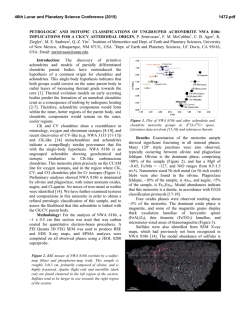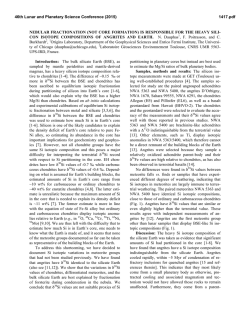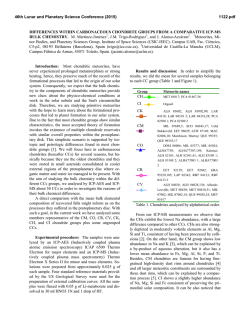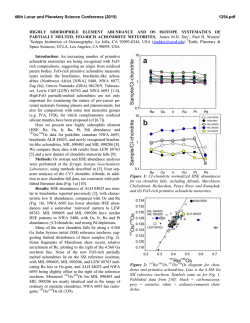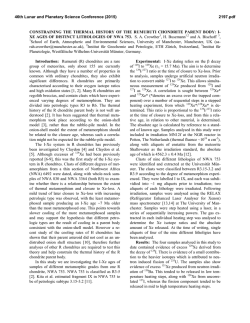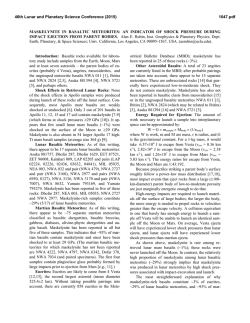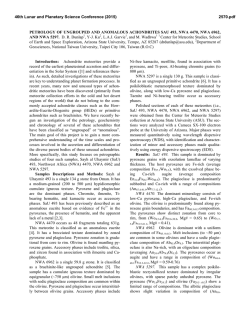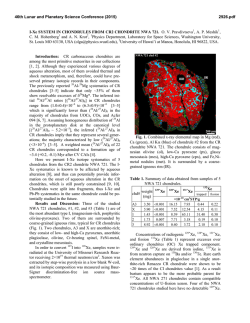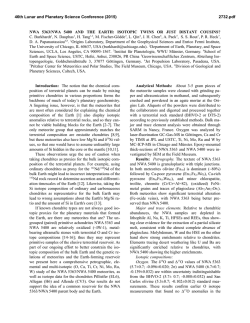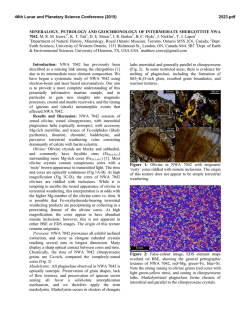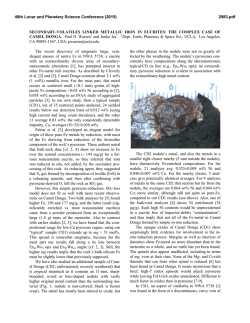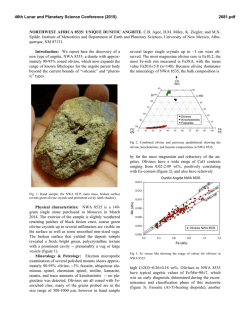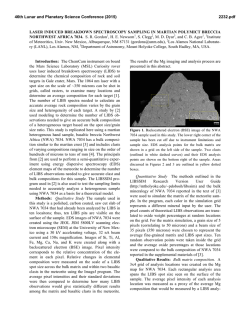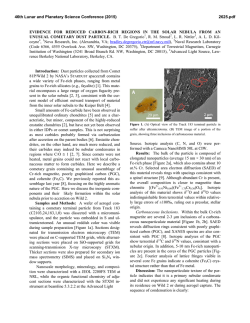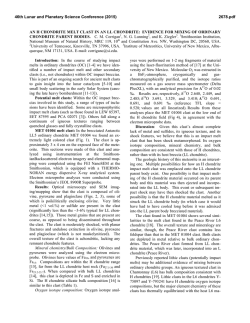
DIFFERENTIATED PLANETESIMALS WITH CHONDRITIC CRUSTS
46th Lunar and Planetary Science Conference (2015) 2259.pdf DIFFERENTIATED PLANETESIMALS WITH CHONDRITIC CRUSTS: NEW Δ 17O-ε 54Cr EVIDENCE IN UNIQUE, UNGROUPED ACHONDRITES FOR PARTIAL MELTING OF THE CV/CK AND CO PARENT BODIES. M. E. Sanborn1, Q.-Z. Yin1, A. J. Irving2, and T. E. Bunch3, Dept. of Earth & Planet. Sci, Univ. of California-Davis, One Shields Ave., Davis, CA 95616 ([email protected]), 2Dept. of Earth & Space Sci, Univ. of Washington, Seattle, WA 98195, 3Dept. of Geology, Northern Arizona Univ., Flagstaff, AZ 86011. Introduction: The primitive, unmelted nature of carbonaceous chondrites has historically been used as evidence that the carbonaceous chondrite parent bodies never experienced widescale melting or differentiation processes. However, this classical view has been augmented in recent years. The paleomagnetic record observed in some carbonaceous chondrites [1] and the discovery of metamorphosed achondrites whose oxygen isotopic and bulk chemical compositions indicate affinities to carbonaceous chondrites [2] have indicated the possibility that some carbonaceous chondrite parent bodies underwent partial magmatic differentiation and even core formation. Subsequent modeling (e.g., [3]) has shown that the presence of an unmelted chondritic crust surrounding a differentiated interior is thermodynamically possible. These observations, combined with previous studies, have identified potential achondrite counterparts to CV/CK and CR chondrites [2,4,5]. However, establishing unique genetic links based on oxygen isotopes can be difficult when multiple meteorite groups can have indistinguishable Δ17O values, and comparison of bulk chemistries alone may not be definitive. The acquisition of highprecision Cr isotope ratios can provide an additional parameter to identify a possible common chemical source, in addition to bulk chemical or oxygen isotopic measurements. For example, we recently utilized the coupled Δ17O-ε54Cr systematics, an increasingly powerful forensic tool, to investigate a group of anomalous achondrites that could potentially be differentiated counterparts to CR chondrites [6]. The evolving picture of the differentiated carbonaceous chondrite parent bodies is reliant on a small, but expanding, set of unique meteorite specimens [2,5-11]. In this study, we work to further characterize some of these unique samples and examine genetic relationships to partially differentiated chondrite parent bodies through the Cr isotopic analysis of a set of four achondritic specimens: Northwest Africa (NWA) 1839, NWA 2788, NWA 3133, and NWA 7822. In a parallel investigation, we have also analyzed the ungrouped C3.0 chondrite NWA 5958 using the Δ17O-ε54Cr forensic system to more fully assess its unique nature in relation to the established carbonaceous chondrite groups. Samples: NWA 1839 is a coarse-grained aggregate of orthopyroxene, plagioclase, and pyroxene with accessory phases of troilite, taenite and chromite [10]. It was originally classified as an L7 ordinary chondrite with an absence of chondrules and a recrystallized texture [10]; however, subsequent oxygen isotope measurements (Δ17O = -4.00±0.26 per mil, D. Rumble, Geophysical Laboratory) have ruled out any affinity to L ordinary chondrites. Additionally, the bulk elemental ratios (e.g., Mn/Mg and Al/Mg) are very similar to those of CO chondrites. NWA 2788 is a metamorphic textured sample composed primarily of orthopyroxene and olivine with lesser amounts of clinopyroxene and plagioclase, and with oxygen isotopic compositions close to the terrestrial fractionation line (Δ17O = -0.09±0.01 per mil) [7]. Some chemical characteristics of the silicate phases (e.g., elevated Fe/Mn ratios) are similar to those observed in the carbonaceous chondrites [7]. NWA 3133 is a chondrule-free, moderately coarsegrained specimen with a metamorphic texture, and major constituent phases of olivine and orthopyroxene with lesser amounts of plagioclase, chromite, Cr diopside, and merrillite [8]. The oxygen isotopic composition of NWA 3133 plots along the CV chondrite trend line and the Al/Mg and Mn/Mg ratios likewise are similar to those observed in Allende and the other CV chondrites [8]. NWA 7822 is a coarse-grained plutonic dunite composed of more than 90% olivine with minor amounts of chromite, taenite, and plagioclase [9]. As with NWA 3133, the oxygen isotopic composition of NWA 7822 plots closely along the CV-CO oxygen trend lines [9]. In contrast to the samples discussed above, NWA 5958 has a clearly chondritic petrography with a dark, fine-grained matrix and a range of chondrule types, with CAIs notably rare [11]. A key feature of NWA 5958 is its oxygen isotopic composition, which is among the most 16O-rich of any carbonaceous chondrite with values plotting along the CCAM line and Δ17O = -7.05 [11]. Methods: Whole-rock powders of each sample were prepared, dissolved, and Cr separated following previously described analytical procedures [6]. Highprecision Cr isotope ratios were measured using a Thermo Triton Plus thermal ionization mass spectrometer at the University of California at Davis. The 54 Cr/52Cr ratios are expressed in ε-notation (parts per 46th Lunar and Planetary Science Conference (2015) 10,000) deviation from the measured terrestrial standards. Results and Discussion: The Cr isotopic results for NWA 1839, NWA 2788, NWA 3133, and NWA 7822 all yield positive ε54Cr values, whereas a majority of achondrites and all ordinary chondrites have ε54Cr < 0 (Figure 1). Figure 1. Isotopic composition of analyzed samples in comparison to other achondrite and chondrite groups. Literature values for Δ17O and ε54Cr are from [5,7-13] and references therein. The Cr isotopic composition of NWA 1839 combined with the oxygen isotopes precludes any genetic link to L chondrites, and in fact the ε54Cr value for NWA 1839 overlaps within error that for Allende (CV3). The bulk elemental ratios plot within the CO chondrite values, however the ε54Cr values are resolved from the single CO sample thus far measured (Lancé, CO3.5). With only a single CO chondrite datum, the extent of the variability of ε54Cr among CO chondrites is not clear and so a connection to a CO chondrite parent body cannot be completely ruled out. However, it is clear from the ε54Cr and Δ17O that the source material for NWA 1839 is similar to that of the carbonaceous chondrites. The ε54Cr isotopic composition of NWA 2788 is similar to the composition observed in other carbonaceous chondrites groups (e.g., CV chondrites) with an ε54Cr of +1.04±0.11, but plots in its own region in Δ17O-ε54Cr space. This indicates that while the precursor material of its parent body is similar in composition to carbonaceous chondrites, a non-equilibrated, chondrule-bearing equivalent has yet to be identified. The measured ε54Cr value of NWA 3133 overlaps, within error, that of the CV chondrite Allende. A previous analysis of NWA 3133 reported a ε54Cr of +1.28±0.11 [14], which was resolvably higher than for CV chondrites. However our ε54Cr value for NWA 3133 is indistinguishable from that for Allende. While 2259.pdf the reason for the difference between these two results is not clear, the ε54Cr for NWA 3133 measured in the present study provides additional evidence for a common source for NWA 3133 and Allende (and by extension all CV chondrites). As with the other two samples, NWA 7822 plots close to the Allende value in Δ17O-ε54Cr space. While the oxygen composition of NWA 7822 plots in a region where it is difficult to distinguish between it and the CO and CV chondrite trends [8], the ε54Cr composition is clearly resolved from the CO value for Lancé (Fig. 1). Notwithstanding the slight difference in ε54Cr between NWA 1839 and Lancé, NWA 1839 may represent the first example of a differentiated counterpart to CO chondrites. With NWA 1839, the evidence from NWA 3133, NWA 7822 and previous studies of Cr isotopic compositions of anomalous achondrites [6], the isotopic evidence establishes that genetic links between achondrites and carbonaceous chondrites are now seen for CV, CK, CO and CR chondrites. This suggests that the melting and partial differentiation of carbonaceous chondrite parent bodies may be much more ubiquitous than an isolated case. Lastly, the measured ε54Cr value for NWA 5958 places this unique sample in its own region on the Δ17O-ε54Cr diagram and consistent with a preliminary value reported previously [15]. As seen in Figure 1, there is an approximate linear correlation among the carbonaceous chondrite groups going from CI to CK chondrites. Northwest Africa 5958 clearly is an exception to this observed trend. Notably, even with the extreme Δ17O composition, the ε54Cr composition is close to the mean value for all carbonaceous chondrites. The results from NWA 5958 indicate that the region in which the carbonaceous chondrites formed had a moderate range in ε54Cr and that parent body processes (that may affect the oxygen isotopic composition) do not significantly affect the ε54Cr. References: [1] Carporzen L. et al. (2011) PNAS, 108, 6386-6389. [2] Irving A. J. e al. (2004) EOS, Abs #P31C-02. [3] Elkins-Tanton L. et al. (2011) EPSL, 305, 1-10. [4] Bunch T. et al. (2005) LPS XXXVI, A2308. [5] Agee C. B. et al. (2014) MetSoc 77, A5385. [6] Sanborn M. E. et al. (2014) LPS XLV, A2032. [7] Bunch T. E. et al. (2006) EOS, Abs# P51E-1246 [8] Schoenbeck T. W. (2006) LPS XXXVII, A1550. [9] Kuehner S. M. (2013) MetSoc 76, A5269. [10] Russell S. S. et al. (2005) MAPS, 40, A201-A263. [11] Bunch T. E. et al. (2011) LPS XLII, A2343. [12] Jenniskens P. et al. (2014) MAPS, 49, 1388-1425. [13] Srinivasan et al. (2015) LPS XLVI, This meeting. [14] Shukolyukov A. et al. (2011) LPS XLII, A1527. [15] Göpel C. et al. (2013) Mineralogical Magazine, 77, 1196.
© Copyright 2025

